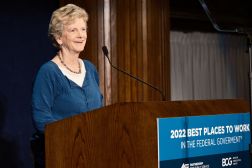Rung lays out IT-heavy agenda for procurement policy office
The Office of Federal Procurement Policy will prioritize its work around IT acquisition in the coming months, Administrator Anne Rung said Tuesday.
Speaking at an acquisition-focused event hosted by ACT-IAC, Rung delivered a keynote introducing several new OFPP initiatives and goals for the coming calendar year, heavily centered on category management through the General Services Administration’s Common Acquisition Platform.
Rung said that within three months, OFPP wants all IT contracts hosted on the platform, which she described as a collection of subject-matter-expert-managed category gateways “for government employees to find contract information, pricing tools, best practices and other data.” The Common Acquisition Platform, she said, breaks down “agency silos” and creates the “simplification and collaboration [that] will lead to improved performance and savings.”
Early IT acquisition moved government buying away from a centralized model led by GSA to give agencies more options in their procurements. But Rung said “the pendulum has now swung completely the other way with unprecedented levels of fragmentation in our buying and enormous proliferation duplicative IT contracts, creating huge inefficiency. Stated another way, the sheer complexity of our organizational framework for IT acquisition is a stranglehold on innovation and efficiency.”
The Office of Management and Budget, which housed OFPP, plans to hire an IT category manager who will work with newly appointed Federal CIO Tony Scott, GSA Assistant Commissioner for the Office of Integrated Technology Services Mary Davie and Rung to improve government’s buying of IT commodities, the OFPP administrator said. Likewise, GSA will hire an IT vendor manager “who will provide full-time focus on improving relationships with key types of vendors, especially those who have multiple contracts for similar goods and services,” she said.
In addition to category management, Rung presented numerous IT acquisition initiatives to keep an eye out for in coming months. To make sure concepts like category management and agile acquisition catch hold in federal government, she said, it’s necessary to strengthen the acquisition workforce.
“Equally important, we must find more effective ways of building that capacity to make sure it’s taking hold,” Rung said. “If we want to develop a digital capability and an agile mindset within the agencies we must ensure that everyone understands the approach and the many benefits.”
Rung said OFPP is partnering with the U.S. Digital Service and GSA “to develop programs to build digital and agile capabilities within the federal government.” In the next few weeks, the office will also issue a challenge on Challenge.gov to “help develop a program to certify contracting professionals in digital services acquisition strategy,” developing “cross-functional training for integrative product teams working on digital acquisitions,” she said.
Within the Common Acquisition Platform, OFPP is developing a TechFAR hub, which will help agencies looking to acquire more innovatively within the legal boundaries of the Federal Acquisition Regulation.
“This hub will be part of a larger hallway that will support the Federal Buyers Club and provide innovative strategies, case studies and resources for any type of procurements,” said Rung, who also plans to release podcast on “how government employees have successfully implemented strategies from the TechFAR and the Digital Services Playbook.”
Lastly, OFPP will introduce something called Acquisition 360 to improve IT acquisition.
“It’s the first ever transaction-based feedback tool that will allow agencies to identify strengths and weaknesses in their acquisition process with a focus on pre-award activities, contract execution and certain post-award activities such as briefings,” Rung said. “This initial effort will give us experience with such as toll and allow us to gain significant insight into where weak points are and where we’re doing well so we can share that with other partners.”
Rung has lofty goals for acquisition through calendar year 2016: more transparency, more data on governmentwide acquisition, and a reduction in procurement fragmentation. But these IT initiatives set a solid framework for improving and innovating acquisition, she said. “While there’s much left to be done, we are well on our way to building a much stronger foundation for delivering results.”






